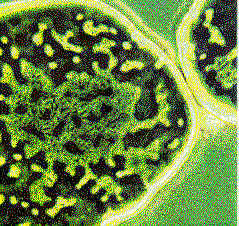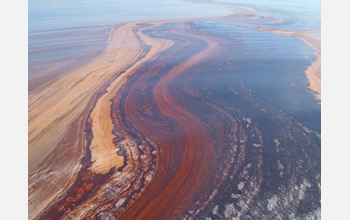Bioremediation (Bioremediation)
Bioremediation
Many methods are employed by public and private agencies to clean up pollution at Superfund and other sites. Some, like bioremediation, are considered new or innovative. Such methods can be quicker and cheaper than more common methods. If you live, work, or go to school near a Superfund site, you may want to learn more about cleanup methods.
What is bioremediation?
Bioremediation allows natural processes to clean up harmful chemicals in the environment. Microscopic “bugs” or microbes that live in soil and groundwater like to eat certain harmful chemicals, such as those found in gasoline (Health effects of gasoline) and oil spills. When microbes completely digest these chemicals, they change them into water and harmless gases such as carbon dioxide.
How does it work?
 Microbes inside an oil drop. The average size of these single cell organisms is about 25,000ths of an inch. Credit: DOE Microbes inside an oil drop. The average size of these single cell organisms is about 25,000ths of an inch. Credit: DOE
|
In order for microbes to clean up harmful chemicals, the right temperature, nutrients (fertilizers), and amount of oxygen must be present in the soil and groundwater. These conditions allow the microbes to grow and multiply—and eat more chemicals. When conditions are not right, microbes grow too slowly or die. Or they can create more harmful chemicals. If conditions are not right at a site, EPA works to improve them. One way they improve conditions is to pump air, nutrients, or other substances (such as molasses) underground. Sometimes microbes are added if enough aren’t already there.
The right conditions for bioremediation cannot always be achieved underground. At some sites, the weather is too cold or the soil is too dense. At such sites, EPA might dig up the soil to clean it above ground where heaters and soil mixing help improve conditions. After the soil is dug up, the proper nutrients are added. Oxygen also may be added by stirring the mixture or by forcing air through it. However, some microbes work better without oxygen. With the right temperature and amount of oxygen and nutrients, microbes can do their work to “bioremediate” the harmful chemicals.
Sometimes mixing soil can cause harmful chemicals to evaporate before the microbes can eat them. To prevent these chemicals from polluting the air, EPA mixes the soil inside a special tank or building where chemicals that evaporate can be collected and treated.
Microbes can help clean polluted groundwater as well as soil. To do this, EPA drills wells and pumps some of the groundwater into tanks. Here, the water is mixed with nutrients and air before it is pumped back into the ground. The added nutrients and air help the microbes bioremediate the groundwater. Groundwater can also be mixed underground by pumping nutrients and air into the wells.
Once harmful chemicals are cleaned up and microbes have eaten their available “food,” the microbes die.
Is bioremediation safe?
Bioremediation is very safe because it relies on microbes that naturally occur in soil. These microbes are helpful and pose no threat to people at the site or in the community. Microbes themselves won’t hurt you, but never touch the polluted soil or groundwater—especially before eating.
No dangerous chemicals are used in bioremediation. The nutrients added to make microbes grow are fertilizers commonly used on lawns and gardens. Because bioremediation changes the harmful chemicals into water and harmless gases, the harmful chemicals are completely destroyed. To ensure that bioremediation is working, EPA tests samples of soil and groundwater.
How long will it take?
The time it takes to bioremediate a site depends on several factors:
- types and amounts of harmful chemicals present
- size and depth of the polluted area
- type of soil and the conditions present
- whether cleanup occurs above ground or underground
These factors vary from site to site. It can take a few months or even several years for microbes to eat enough of the harmful chemicals to clean up the site.
Why use bioremediation?
 Researchers are studying the impact of the oil spill on microbes in Gulf waters and sediments. Credit: NSF Researchers are studying the impact of the oil spill on microbes in Gulf waters and sediments. Credit: NSF
|
EPA uses bioremediation because it takes advantage of natural processes. Polluted soil and groundwater can be cleaned at the site without having to move them somewhere else. If the right conditions exist or can be created underground, soil and groundwater can be cleaned without having to dig or pump it up at all. This allows cleanup workers to avoid contact with polluted soil and groundwater. It also prevents the release of harmful gases into the air. Because microbes change the harmful chemicals into water and harmless gases, few if any wastes are created.
Often bioremediation does not require as much equipment or labor as most other methods. Therefore, it is usually cheaper. Bioremediation has successfully cleaned up many polluted sites and is being used at 50 Superfund sites across the country.

